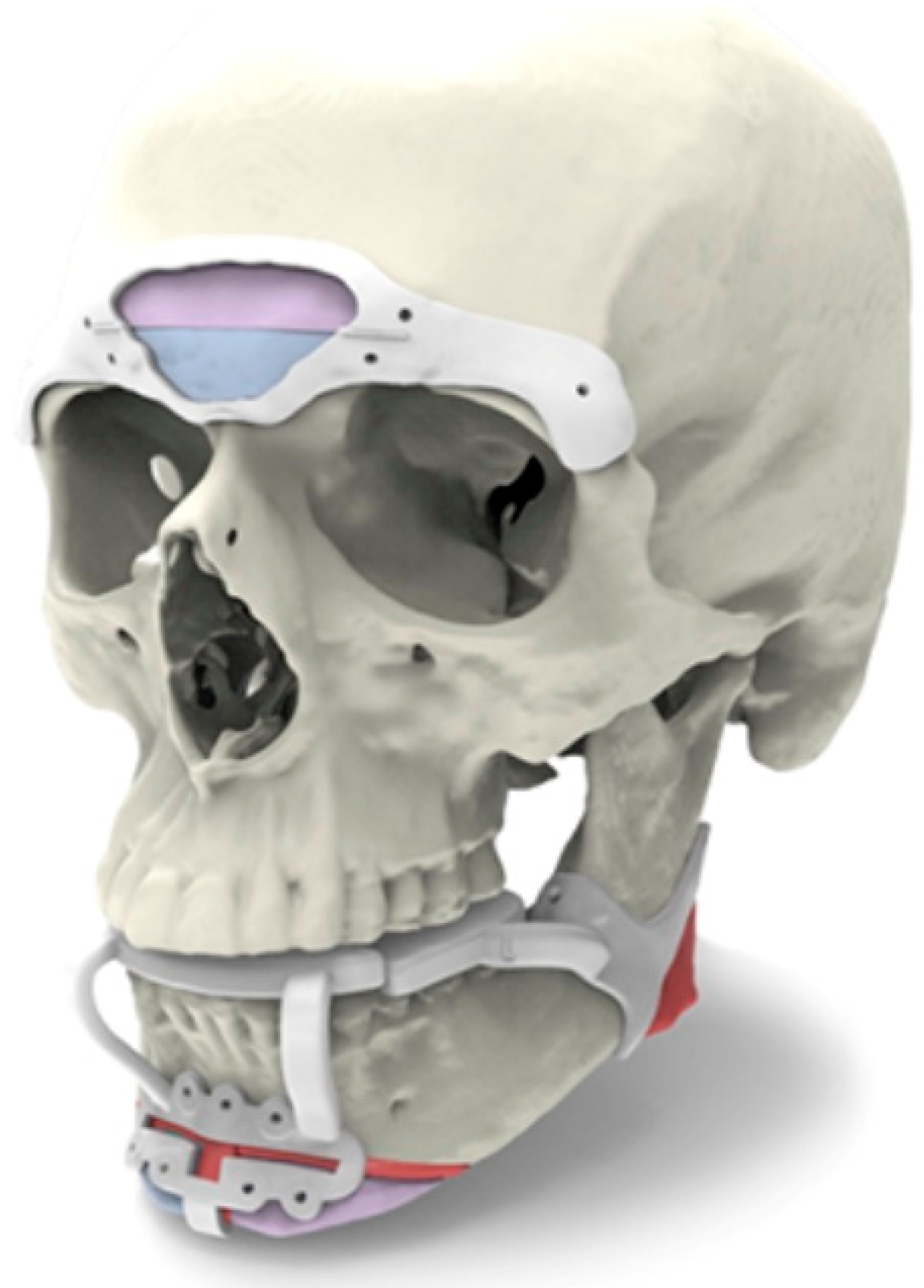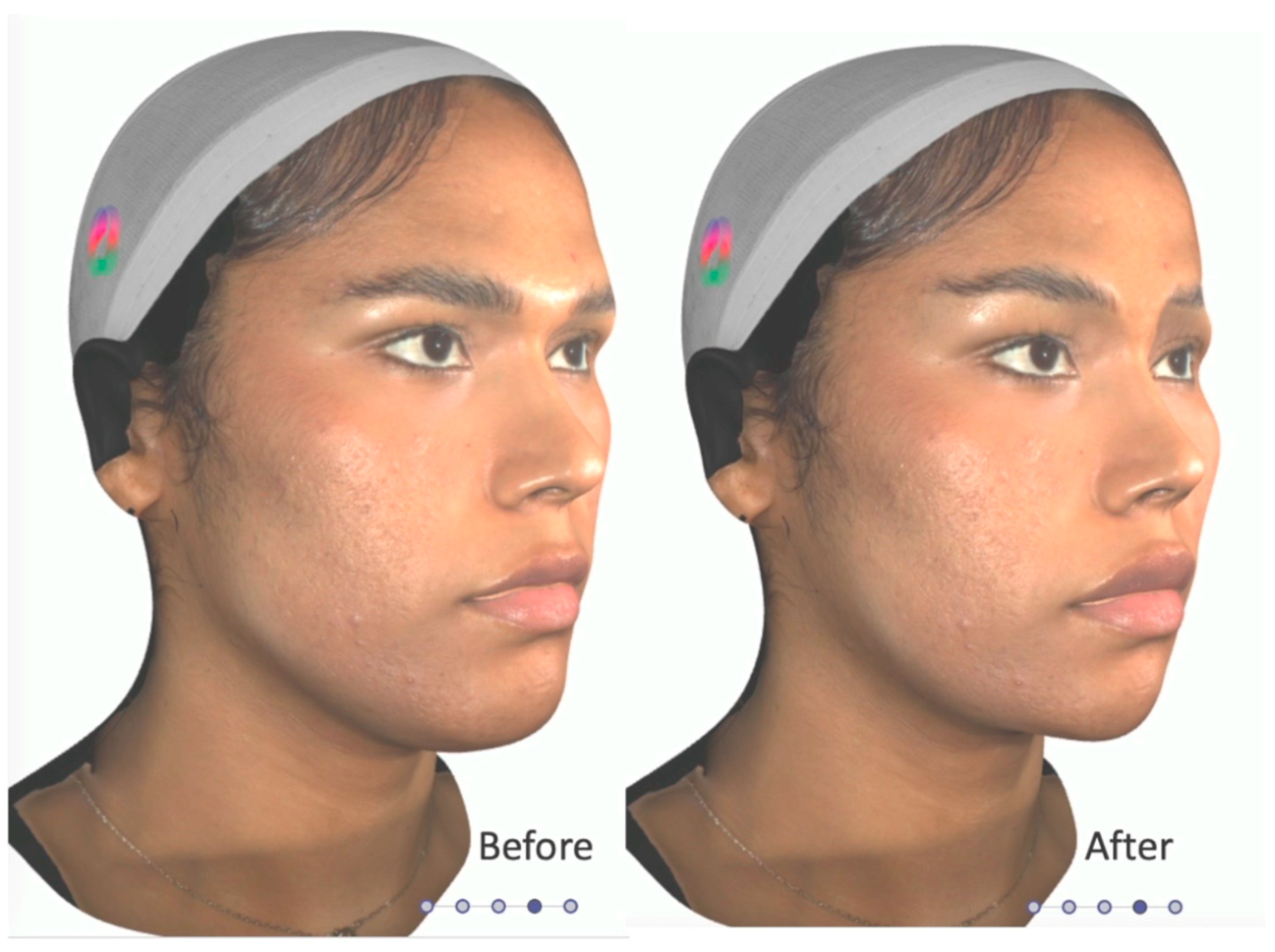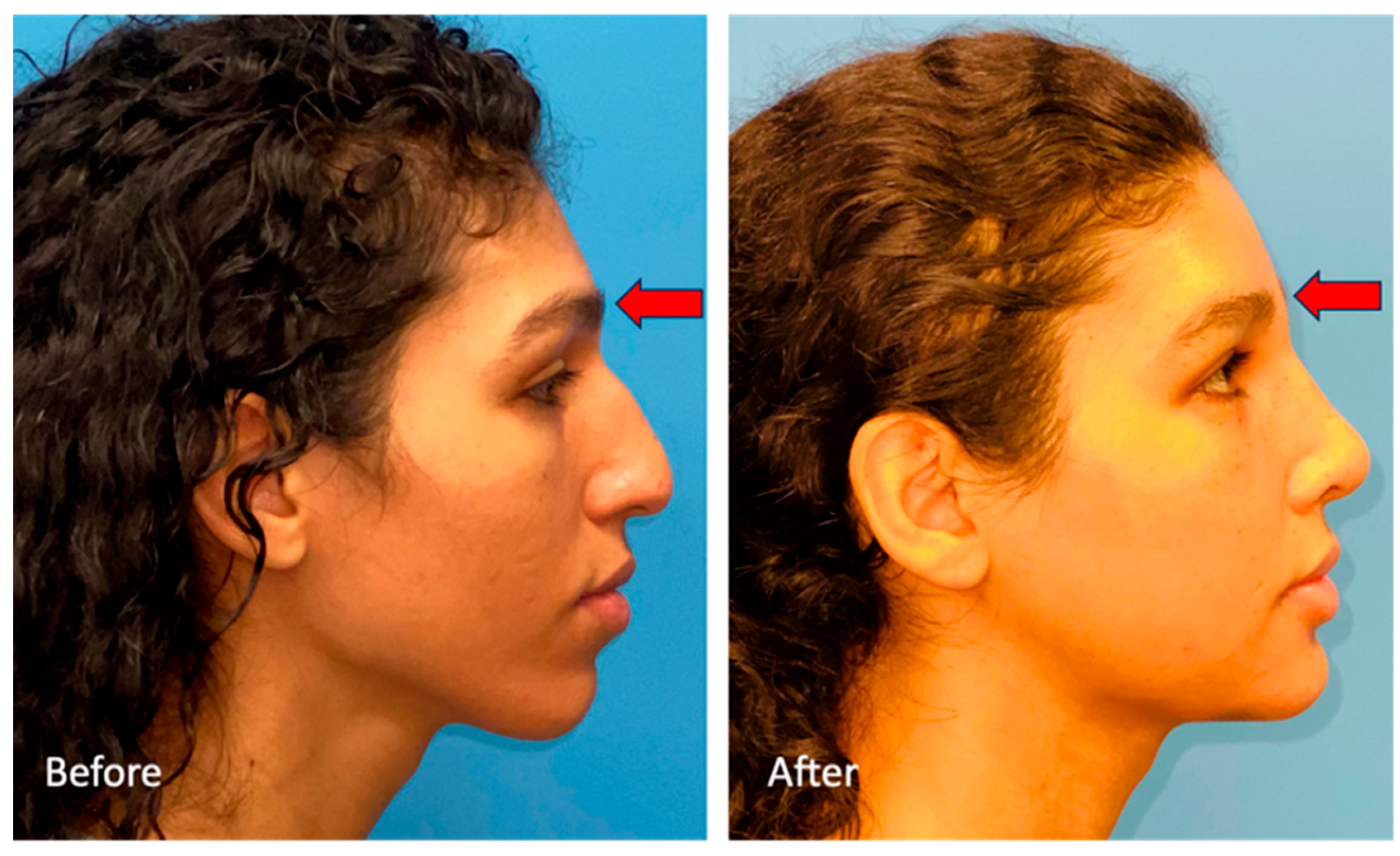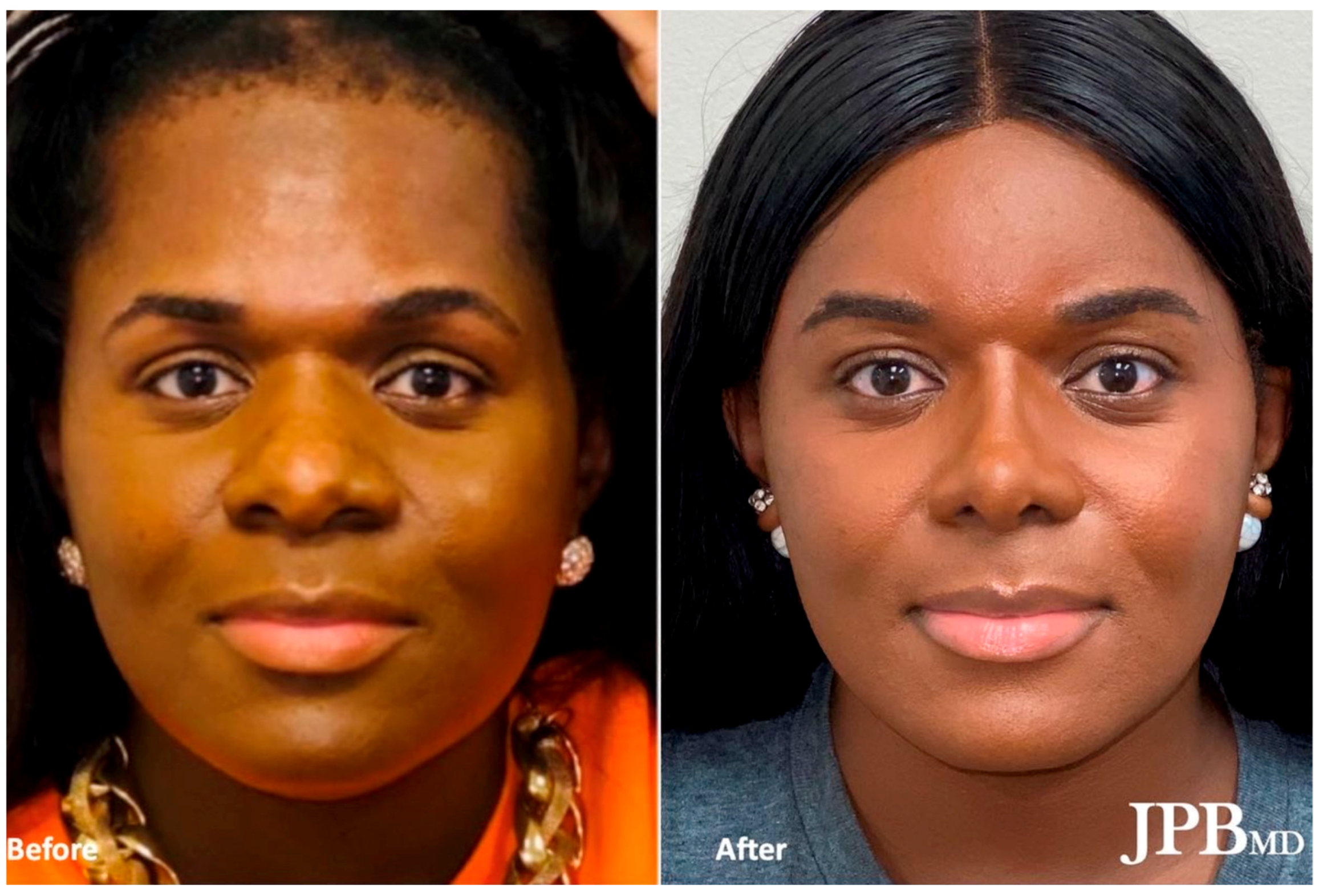Facial Feminization Surgery: Anatomical Differences, Preoperative Planning, Techniques, and Ethical Considerations
Abstract
1. Introduction
2. Key Anatomical Differences between Male and Female Facial Regions and Surgical Modification
2.1. Forehead/Brow
2.2. Jawline
2.3. Neck
2.4. Nose
2.5. Lips
2.6. Cheeks
3. Preoperative Planning
3.1. Virtual Planning
3.2. Artificial Intelligence Preoperative Morphing
4. General Craniofacial Techniques by Region
4.1. Brow
4.2. Jawline
4.3. Neck
4.4. Nose
4.5. Lips
4.6. Cheeks
5. Special Circumstances
5.1. Procedure Sequence and Timing
5.2. The Older Patient
5.3. Silicone Removal
6. Perioperative Care
7. Clinical Outcomes
8. Future Perspectives
9. Ethical Considerations
10. Conclusions
Author Contributions
Funding
Institutional Review Board Statement
Informed Consent Statement
Data Availability Statement
Conflicts of Interest
References
- Beek, T.F.; Cohen-Kettenis, P.T.; Kreukels, B.P. Gender incongruence/gender dysphoria and its classification history. Int. Rev. Psychiatry 2016, 28, 5–12. [Google Scholar] [CrossRef]
- Coleman, E.; Bockting, W.; Botzer, M.; Cohen-Kettenis, P.; DeCuypere, G.; Feldman, J.; Fraser, L.; Green, J.; Knudson, G.; Meyer, W.J.; et al. Standards of Care for the Health of Transsexual, Transgender and Gender-Nonconforming People, Version 7. Int. J. Transgend. 2012, 13, 165–232. [Google Scholar] [CrossRef]
- Plemons, E.D. Description of sex difference as prescription for sex change: On the origins of facial feminization surgery. Soc. Stud. Sci. 2014, 44, 657–679. [Google Scholar] [CrossRef] [PubMed]
- Nold, S.L.; Horvath, S.D.; Stampf, S.; Blatz, M.B. Analysis of select facial and dental esthetic parameters. Int. J. Periodontics Restor. Dent. 2014, 34, 623–629. [Google Scholar] [CrossRef] [PubMed]
- Ainsworth, T.A.; Spiegel, J.H. Quality of life of individuals with and without facial feminization surgery or gender reassignment surgery. Qual. Life Res. 2010, 19, 1019–1024. [Google Scholar] [CrossRef] [PubMed]
- Ousterhout, D.K. Feminization of the forehead: Contour changing to improve female aesthetics. Plast. Reconstr. Surg. 1987, 79, 701–713. [Google Scholar] [CrossRef] [PubMed]
- Gray, R.; Nguyen, K.; Lee, J.C.; Deschamps-Braly, J.; Bastidas, N.; Tanna, N.; Bradley, J.P. Osseous Transformation with Facial Feminization Surgery: Improved Anatomical Accuracy with Virtual Planning. Plast. Reconstr. Surg. 2019, 144, 1159–1168. [Google Scholar] [CrossRef] [PubMed]
- Altman, K. Facial feminization surgery: Current state of the art. Int. J. Oral Maxillofac. Surg. 2012, 41, 885–894. [Google Scholar] [CrossRef]
- Sedgh, J. The Aesthetics of the Upper Face and Brow: Male and Female Differences. Facial Plast. Surg. 2018, 34, 114–118. [Google Scholar] [CrossRef]
- Choe, J.; Parikh, S.; Barnett, S.L.; Sam, S.; Chen, K.; Bradley, J.P. Facial feminization surgery review: Diagnosis, preoperative planning, surgical techniques, and outcomes. FACE 2021, 2, 426–435. [Google Scholar] [CrossRef]
- Morrison, S.D.; Vyas, K.S.; Motakef, S.; Gast, K.M.; Chung, M.T.; Rashidi, V.; Satterwhite, T.; Kuzon, W.; Cederna, P.S. Facial Feminization: Systematic Review of the Literature. Plast. Reconstr. Surg. 2016, 137, 1759–1770. [Google Scholar] [CrossRef] [PubMed]
- Hage, J.J.; Becking, A.G.; de Graaf, F.H.; Tuinzing, D.B. Gender-confirming facial surgery: Considerations on the masculinity and femininity of faces. Plast. Reconstr. Surg. 1997, 99, 1799–1807. [Google Scholar] [CrossRef] [PubMed]
- Deschamps-Braly, J.C. Approach to Feminization Surgery and Facial Masculinization Surgery: Aesthetic Goals and Principles of Management. J. Craniofac. Surg. 2019, 30, 1352–1358. [Google Scholar] [CrossRef] [PubMed]
- Salgado, C.J.; Nugent, A.G.; Satterwaite, T.; Carruthers, K.H.; Joumblat, N.R. Gender Reassignment: Feminization and Masculinization of the Neck. Clin. Plast. Surg. 2018, 45, 635–645. [Google Scholar] [CrossRef] [PubMed]
- Bellinga, R.J.; Capitán, L.; Simon, D.; Tenório, T. Technical and Clinical Considerations for Facial Feminization Surgery With Rhinoplasty and Related Procedures. JAMA Facial Plast. Surg. 2017, 19, 175–181. [Google Scholar] [CrossRef]
- Telang, P.S. Facial Feminization Surgery: A Review of 220 Consecutive Patients. Indian J. Plast. Surg. 2020, 53, 244–253. [Google Scholar] [CrossRef]
- Facque, A.R.; Atencio, D.; Schechter, L.S. Anatomical Basis and Surgical Techniques Employed in Facial Feminization and Masculinization. J. Craniofac. Surg. 2019, 30, 1406–1408. [Google Scholar] [CrossRef]
- Herford, A.S.; Stringer, D.E.; Tandon, R. Mandibular surgery: Technologic and technical improvements. Oral Maxillofac. Surg. Clin. N. Am. 2014, 26, 487–521. [Google Scholar] [CrossRef]
- Fu, X.; Qiao, J.; Girod, S.; Niu, F.; Liu, J.F.; Lee, G.K.; Gui, L. Standardized protocol for visual surgical plan and 3-dimensional surgical template-assisted single-stage mandible contour surgery. Ann. Plast. Surg. 2017, 79, 236–242. [Google Scholar] [CrossRef]
- Steinbacher, D.M. Three-dimensional analysis and surgical planning in craniomaxillofacial surgery. J. Oral Maxillofac. Surg. 2015, 73, S40–S56. [Google Scholar] [CrossRef]
- Tawa, P.; Brault, N.; Luca-Pozner, V.; Ganry, L.; Chebbi, G.; Atlan, M.; Qassemyar, Q. Three-Dimensional Custom-Made Surgical Guides in Facial Feminization Surgery: Prospective Study on Safety and Accuracy. Aesthet. Surg. J. 2021, 41, NP1368–NP1378. [Google Scholar] [CrossRef]
- Rokaya, D.; Suttagul, K.; Maharjan, S.K.; Sapkota, B. Gender based comparison of the relationships of maxillary anterior teeth and facial measurements. J. Int. Dent. Medical Res. 2018, 11, 465–469. [Google Scholar]
- Camison, L.; Bykowski, M.; Lee, W.W.; Carlson, J.C.; Roosenboom, J.; Goldstein, J.A.; Losee, J.E.; Weinberg, S.M. Validation of the Vectra H1 portable three-dimensional photogrammetry system for facial imaging. Int. J. Oral Maxillofac. Surg. 2018, 47, 403–410. [Google Scholar] [CrossRef]
- Surgeon Info. Deep Surface AI. Available online: https://www.deepsurfaceai.com/ (accessed on 21 July 2023).
- Parsa, S.; Basagaoglu, B.; Mackley, K.; Aitson, P.; Kenkel, J.; Amirlak, B. Current and Future Photography Techniques in Aesthetic Surgery. Aesthet. Surg. J. Open Forum 2021, 4, ojab050. [Google Scholar] [CrossRef] [PubMed]
- Fan, W.; Rokohl, A.C.; Maus, J.; Guo, Y.; Ju, X.; Li, X.; Matos, P.A.W.; Heindl, L.M. Evaluation of the Portable Next-Generation VECTRA H2 3D Imaging System for Measuring Upper Eyelid Area and Volume. Aesthet. Surg. J. 2023, 43, 1114–1123. [Google Scholar] [CrossRef] [PubMed]
- Vorstenbosch, J.; Islur, A. Correlation of Prediction and Actual Outcome of Three-Dimensional Simulation in Breast Augmentation Using a Cloud-Based Program. Aesthetic Plast. Surg. 2017, 41, 481–490. [Google Scholar] [CrossRef] [PubMed]
- Fishman, Z.; Liu, J.; Pope, J.; Fialkov, J.A.; Whyne, C.M. Validating 3D face morphing towards improving pre-operative planning in facial reconstruction surgery. Comput. Methods Biomech. Biomed. Eng. Imaging Vis. 2021, 9, 480–487. [Google Scholar] [CrossRef]
- Hutchinson, L.E.; Castaldo, A.D.; Malone, C.H.; Sommer, N.Z.; Amalfi, A.N. A Pilot Study Evaluation of 3-Dimensional Imaging in Cosmetic Breast Augmentation: Results of a Single Surgeon 3.5-Year Retrospective Study Using the BREAST-Q Questionnaire. Aesthet. Surg. J. Open Forum 2021, 3, ojab005. [Google Scholar] [CrossRef]
- Spiegel, J.H. Facial Feminization for the Transgender Patient. J. Craniofac. Surg. 2019, 30, 1399–1402. [Google Scholar] [CrossRef]
- Deschamps-Braly, J. Feminization of the Chin: Genioplasty Using Osteotomies. Facial Plast. Surg. Clin. N. Am. 2019, 27, 243–250. [Google Scholar] [CrossRef]
- Spiegel, J.H.; Rodriguez, G. Chondrolaryngoplasty under general anesthesia using a flexible fiberoptic laryngoscope and laryngeal mask airway. Arch. Otolaryngol. Head Neck Surg. 2008, 134, 704–708. [Google Scholar] [CrossRef]
- Davis, A.M.; Simons, R.L.; Rhee, J.S. Evaluation of the Goldman tip procedure in modern-day rhinoplasty. Arch. Facial Plast. Surg. 2004, 6, 301–307. [Google Scholar] [CrossRef][Green Version]
- Choi, J.Y. Alar Base Reduction and Alar-Columellar Relationship. Facial Plast. Surg. Clin. N. Am. 2018, 26, 367–375. [Google Scholar] [CrossRef] [PubMed]
- Rohrich, R.J.; Afrooz, P.N. Primary Open Rhinoplasty. Plast. Reconstr. Surg. 2019, 144, 102e–117e. [Google Scholar] [CrossRef]
- Trussler, A.P.; Kawamoto, H.K.; Wasson, K.L.; Dickinson, B.P.; Jackson, E.; Keagle, J.N.; Jarrahy, R.; Bradley, J.P. Upper lip augmentation: Palmaris longus tendon as an autologous filler. Plast. Reconstr. Surg. 2008, 121, 1024–1032. [Google Scholar] [CrossRef] [PubMed]
- Spiegel, J.H. The Modified Bullhorn Approach for the Lip-lift. JAMA Facial Plast. Surg. 2019, 21, 69–70. [Google Scholar] [CrossRef]
- Kaufman, M.R.; Miller, T.A.; Huang, C.; Roostaien, J.; Wasson, K.L.; Ashley, R.K.; Bradley, J.P. Autologous fat transfer for facial recontouring: Is there science behind the art? Plast. Reconstr. Surg. 2007, 119, 2287–2296. [Google Scholar] [CrossRef] [PubMed]
- Capitán, L.; Santamaría, J.G.; Simon, D.; Coon, D.; Bailón, C.; Bellinga, R.J.; Tenório, T.; Capitán-Cañadas, F. Facial Gender Confirmation Surgery: A Protocol for Diagnosis, Surgical Planning, and Postoperative Management. Plast. Reconstr. Surg. 2020, 145, 818e–828e. [Google Scholar] [CrossRef]
- Chaya, B.F.; Berman, Z.P.; Boczar, D.; Siringo, N.; Colon, R.R.; Trilles, J.; Diep, G.K.; Rodriguez, E.D. Current Trends in Facial Feminization Surgery: An Assessment of Safety and Style. J. Craniofac. Surg. 2021, 32, 2366–2369. [Google Scholar] [CrossRef]
- Raffaini, M.; Perello, R.; Tremolada, C.; Agostini, T. Evolution of Full Facial Feminization Surgery: Creating the Gendered Face With an All-in-one Procedure. J. Craniofac. Surg. 2019, 30, 1419–1424. [Google Scholar] [CrossRef]
- Raffaini, M.; Magri, A.S.; Agostini, T. Full Facial Feminization Surgery: Patient Satisfaction Assessment Based on 180 Procedures Involving 33 Consecutive Patients. Plast. Reconstr. Surg. 2016, 137, 438–448. [Google Scholar] [CrossRef] [PubMed]
- Altmeyer, M.D.; Anderson, L.L.; Wang, A.R. Silicone migration and granuloma formation. J. Cosmet. Dermatol. 2009, 8, 92–97. [Google Scholar] [CrossRef] [PubMed]
- Park, M.E.; Curreri, A.T.; Taylor, G.A.; Burris, K. Silicone Granulomas, a Growing Problem? J. Clin. Aesthet. Dermatol. 2016, 9, 48–51. [Google Scholar] [PubMed]
- Fisher, M.; Lu, S.M.; Chen, K.; Zhang, B.; Di Maggio, M.; Bradley, J.P. Facial Feminization Surgery Changes Perception of Patient Gender. Aesthet. Surg. J. 2020, 40, 703–709. [Google Scholar] [CrossRef]
- Chen, K.; Lu, S.M.; Cheng, R.; Fisher, M.; Zhang, B.H.; Di Maggio, M.; Bradley, J.P. Facial Recognition Neural Networks Confirm Success of Facial Feminization Surgery. Plast. Reconstr. Surg. 2020, 145, 203–209. [Google Scholar] [CrossRef]
- Teixeira, J.C.; Morrison, S.D.; Brandstetter, K.A.; Nuara, M.J. Is there an increasing interest in facial feminization surgery? A search trends analysis. J. Craniofac. Surg. 2020, 31, 606–607. [Google Scholar] [CrossRef]
- WPATH. Position Statement on Medical Necessity of Treatment, Sex Reassignment, and Insurance Coverage in the U.S.A. Available online: https://www.wpath.org/newsroom/medical-necessity-statement (accessed on 21 December 2022).





Disclaimer/Publisher’s Note: The statements, opinions and data contained in all publications are solely those of the individual author(s) and contributor(s) and not of MDPI and/or the editor(s). MDPI and/or the editor(s) disclaim responsibility for any injury to people or property resulting from any ideas, methods, instructions or products referred to in the content. |
© 2023 by the authors. Licensee MDPI, Basel, Switzerland. This article is an open access article distributed under the terms and conditions of the Creative Commons Attribution (CC BY) license (https://creativecommons.org/licenses/by/4.0/).
Share and Cite
Barnett, S.L.; Choe, J.; Aiello, C.; Bradley, J.P. Facial Feminization Surgery: Anatomical Differences, Preoperative Planning, Techniques, and Ethical Considerations. Medicina 2023, 59, 2070. https://doi.org/10.3390/medicina59122070
Barnett SL, Choe J, Aiello C, Bradley JP. Facial Feminization Surgery: Anatomical Differences, Preoperative Planning, Techniques, and Ethical Considerations. Medicina. 2023; 59(12):2070. https://doi.org/10.3390/medicina59122070
Chicago/Turabian StyleBarnett, Sarah L., Joshua Choe, Christopher Aiello, and James P. Bradley. 2023. "Facial Feminization Surgery: Anatomical Differences, Preoperative Planning, Techniques, and Ethical Considerations" Medicina 59, no. 12: 2070. https://doi.org/10.3390/medicina59122070
APA StyleBarnett, S. L., Choe, J., Aiello, C., & Bradley, J. P. (2023). Facial Feminization Surgery: Anatomical Differences, Preoperative Planning, Techniques, and Ethical Considerations. Medicina, 59(12), 2070. https://doi.org/10.3390/medicina59122070





